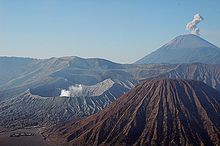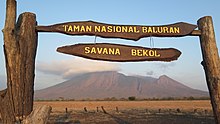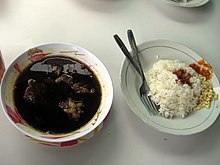
East Java (Jawa Timur) covers the eastern third of the island of Java, Indonesia, as well as the island of Madura and several small offshore islands.
Regions
editCities
edit
- 1 Surabaya — capital of the region; Indonesia's second-largest city and a huge industrial sprawl
- 2 Banyuwangi — the Ijen Crater, famous Java arabica coffee plantations and ferries to Bali
- 3 Kediri — Mount Kelud, Brantas river, waterfalls, and significant archeological sites
- 4 Madiun — verdant agriculture, rail industry and Mount Wilis
- 5 Malang — cool, clean air and the ancient seat of the Kanjuruhan and Singhasari Kingdom
- 6 Ponorogo — home of Reog and known for the origin place of satay
- 7 Probolinggo — gateway to the Bromo-Tengger-Semeru National Park
Other destinations
edit- 1 Baluran National Park — large forest and coastal park and relatively easy access to and from Bali
- 2 Bawean — an island with deer and a white sand beach
- 3 Bromo-Tengger-Semeru National Park — popular hiking destination featuring the still-rumbling Mount Bromo
- 4 Pacet — mountainous district

Understand
editThe spine of East Java is dominated by a series of rugged, spectacular volcanic peaks. The most famous of these are in the Bromo-Tengger-Semeru National Park and Semeru and Bromo together make up one of the great iconic images of Indonesia. There are four volcanic peaks higher than 3,000 m in the region. This volcanic activity has created a largely fertile area and verdant agriculture is a prominent feature of the area.
Both the north and south coasts offer some beautiful, deep, fine sand beaches and these are another key attraction of the region.
The two large southern national parks of Alas Purwo and Meru Betiri are remote and sparsely populated and represent the nearest thing to a wilderness experience that you will find on Java. In the north-east, Baluran National Park recalls African Savannah plains.
The island of Madura sits off the north eastern coast of the region and is as off-the-beaten-track as you can get in this part of Indonesia. That is slowly changing as the road bridge linking Surabaya to Madura opened in mid-2009.
Surabaya is the capital city and Indonesia's second largest. It is though largely bereft of attractions, over-crowded, polluted and supports sprawling industry. Few visitors stay in Surabaya for reasons of tourism. Malang is the second city of the region and a bigger contrast to Surabaya could not be imagined. It is a clean, airy city with an important and interesting history.
Talk
editPeople in East Java speak Indonesian as well as Javanese which they mix together at times. A significant minority also speak Madurese. English will be understood and spoken at large city hotels and at obvious tourist destinations.
For all place names, beware that in the local East Javanese accent, "A" and "O" are largely interchangeable: often the official spelling uses "A", but the locals pronounce it "O". Hence a resident of Surabaya is locally an arek Suroboyo and Cemoro Lawang and Cemara Lawang are the same place.
Get in
editBy plane
editSurabaya's Juanda Airport (SUB IATA) is one of the busiest in Indonesia, with very frequent flights from Jakarta, Bali and other major Indonesian destinations. There are some direct international flights from destinations including Singapore, Kuala Lumpur, Johor Bahru, Hong Kong, Taipei, and Bandar Seri Begawan.
Malang's Abdul Rachman Saleh Airport (MLG IATA) is a smaller airport with a few flights everyday from Jakarta, Bandung and Bali. Heavy traffic is common between Surabaya and Malang, though, so you should strongly consider flying directly to Malang if that's your destination. Blimbingsari Airport (BWX IATA) near Banyuwangi on the eastern tip of Java sees some scheduled flights from Bali (and Surabaya).
By train
editSurabaya is connected by rail from Jakarta, Semarang, Yogyakarta and Banyuwangi with many stops in between. Booking online with a credit card is possible on traveloka. Always prefer the "Executive" class to travel.
The popular star tourist attraction of Bromo-Tengger-Semeru National Park is sadly not part of the Indonesian rail network.
By ferry
editFerries ply the route between Gilimanuk, Bali and Banyuwangi every 20 min, 24 hr a day. The crossing itself takes about 30 min, although embarking and disembarking can take much longer.
Surabaya is a major port and virtually every major coastal city in Indonesia is connected to it in some way. Check the national passenger ship operator PELNI's website for detailed information.
By bus
editGet around
editBy car
editDriving anywhere in Java is a hazardous business for visitors not used to Indonesian driving habits. East Java is no exception and visitors are advised to rent a car with a driver if this is your chosen method of getting around in the region.
By train
editThe region is well served by the national rail network which connects all major cities and towns.
By plane
editFor getting to some of the more remote parts of the province, flying can be an option. There are scheduled flights from Surabaya's Juanda Airport to Banyuwangi (BWX IATA) and Jember (JBB IATA) in the east of the province, Sumenep (SUP IATA) on the island of Madura, and the remote island of Bawean (BXW IATA).
See
edit
The Bromo-Tengger-Semeru National Park is the main attraction in East Java and accounts for a large percentage of overseas tourists who visit the region. The national park is named after its two mountains, Mount Semeru (the highest in Java at 3,676 m, Mount Bromo. the most popular. The Tengger people inhabit this area. Mount Semeru also known as Mahameru (Indonesian language holy mountain or seat of the gods), is one of Indonesia's most active volcanoes. Semeru is often closed due to its highly active nature.
There are many opportunities for trekking in the park to suite all levels of physical fitness. One of the most popular activities (especially for the less energetic!) is to stay in one of the simple lodges in the park, then drive up to the top of Mount Penanjakan (2,770 m) pre-dawn in a 4x4 vehicle and wait for a truly spectacular sunrise. Later in the day, a slightly more arduous 90 min climb up to the rim of the Mount Bromo caldera to view the bubbling active crater is very worthwhile. You can also make this ascent seated atop one of the local ponies.


The Ijen Plateau near Banyuwangi and Bondowoso is a less well known but in its own way equally spectacular area of volcanic activity. The Ijen Plateau is the centrepoint of the large mountain range west of Banyuwangi and which abuts the Baluran National Park to the north. For the adventurous traveller a visit to the Ijen crater (Kawah Ijen) is a must whilst in the region. The crater can be approached from Bondowoso in the west or Banyuwangi in the east. The Bondowoso route is recommended as the road is relatively better (although that is not saying much) and the 90 min foot climb much easier. When you arrive the colour of the water in the lake is scarcely believable being an extraordinary vivid aqua blue. Evidence of volcanic activity is everywhere with steaming water and brilliant yellow crystalline sulphur deposits. The Ijen Crater is one of the great natural wonders of Indonesia. Since BBC and National Geographic mentioned Ijen blue fire/flame crater, more tourists have visited Ijen Crater, not only during the day but also for a new (as of 2014) midnight trip to see the blue fire. These trips are guided and require a mask which can filter sulphur dioxide. Midnight trips require 2 hours hike up to the rim of the crater and 45 minutes to hike down to the bank of the crater.
Malang is a city of great historical significance. It was a seat of major power in Java's Hindu past and the Dutch took a great liking to its relatively cool, fresh climate in the colonial period. Modern day Malang, although significantly urbanised, has retained much of its historical character and a few days looking around this lovely city and visiting nearby places of interest, will be time well spent. In the city centre a great first stop is Ijen Boulevard. This is a quite beautiful street lined with tropical trees against a backdrop of old colonial structures. The street houses a number of interesting buildings including the Brawijaya Army Museum, Immanual Catholic Church and the city library. Nearby Jalan Tugu is home of the city hall (Balai Kota Malang), the Tugu Monument, and Alun-Alun Bunder (park).

About 30 km south of Malang there are three lovely beaches close together: Balekambang, Ngliyep and Sendangbiru. It is best to visit on weekdays as this is a very popular weekend escape and it can get crowded. It is not safe to swim here but these are great relaxation beaches which offer some stunning coastal scenery. There is an offshore island called Pulau Sempu which can be visited by chartering a boat from Sedangbiru beach. At Balekambang beach there are three little islets just offshore which are attached to the beach by walkways. Of the three beaches, Balekambang itself is the most attractive. The beaches are easily day-tripped from Malang in a car.
The Bondowoso region has many ancient stones spread across several districts including kenong stone, grave stones, sarkofag, and others. Alun-alun (city square) is the main place to gather people (the crowd), to the north stood the Regent Hall, which is an old building, and there are also Dutch heritage building that is now a Junior High School 1 Bondowoso. There are many more Dutch heritage buildings in this city. About 10 km east of Bondowoso, there is a brass handicraft centre (Cindogo). Kalianyar village (sub-district Tamanan), 15 km south of Bondowoso is a good destination if you want to enjoy the countryside with cool air.
Baluran National Park is a large forest and coastal park. It has a relatively easy access to and from Bali. It is often said to be the Africa of Java because of the savannah grasslands.
Madura is a dry and crowded island very much off the beaten path for visitors. It is home to the tradition of bull racing (kerapan sapi).
- Purwodadi Botanical Garden. Enjoy the various plants and flowers at Purwodadi Botanical Garden, Pasuruan.

- Reog dance. Go to Ponorogo to watch famed reog dance.
- Sidoarjo mud flow. Observe Lapindo Hot Mud at Porong, Sidoarjo.
- Teksas Wonocolo seeing. A traditional oil drilling that uses teak wood rig in Bojonegoro. It becomes the earliest oil and gas tourism in Indonesia.
Do
edit
- Ride in a 4x4 up Mount Penanjakan in the Bromo-Tengger-Semeru National Park and experience one of the world's great sunrises.
- Surf at G-Land near Banyuwangi.
- Birdwatching in the Baluran National Park.
- Mountaineering on the highest mountain in Java, Mount Semeru.
- Collect some sulphur crystals at the Ijen Crater near Banyuwangi.
- Get off the beaten track and drive over the new bridge to the island of Madura.
- Watch a turtle laying eggs at Sukamade beach.
- Rafting in Pekalen river, Probolinggo.
- Taman Safari — in slope of Mount Arjuno, it is the largest safari park in Asia with 350 hectares area in Pasuruan.

- Theme parks in Batu and Lamongan.
- Feel the splash of fresh water at Kakek Bodo Waterfall near Tretes.
- Learn the history of the majestic Majapahit Kingdom near Mojokerto.
- See the whale sharks: from January to March you can see whale sharks near Probolinggo. Just go to Bentar beach and ask a boat to bring you there.
- 6 hours hike above the Jolotundo Temple or hike around the Bekel volcano: this hike will walk through old Hindu temples from the 10th century.
- Strolling around and swimming in the white sand beaches in Pacitan and Trenggalek.
Eat
editWestern food is available in the large cities of Surabaya and Malang but there are so many local delights that any visitor is surely better off concentrating on these. Indonesian cuisine from all corners of this vast nation is widely available. As elsewhere in Indonesia, the best bet is often simple warungs and roadside stalls and the rule is to follow the local crowds.
The food of East Java is similar to that of Central Java. East Java foods tend to be less sweet and spicier compared to the Central Java ones. Fish and fish/seafood products are quite extensive, and terasi (dried shrimp paste) and petis udang (black colored shrimp paste) are used a great deal. Specific East Javanese specialties include:
- Bakso/bakwan Malang, Malang meatball soup with wontons and noodles
- Lontong balap, bean sprouts and tofu with rice cakes
- Lontong kupang, tiny clam soup with rice cakes from Sidoarjo
- Orem-orem, pressed rice, chicken, tempeh, bean sprouts, sweet soy sauce, coconut milk, and peanuts.
- Pecel lele, deep fried catfish served with rice and sambal
- Pecel tumpang, an East Java salad mixed with peanut and tempeh sauce

- Rawon, dark beef soup
- Rujak cingur, a salad with spicy sauce and cingur (slices of cooked cow nose).
- Sate kelopo, satay with coconut rasp.
- Sate Madura, Madura chicken satay.
- Semanggi Surabaya, marsilea leaves with spicy sweet potato sauce
- Soto Lamongan, a typical chicken soto from Lamongan
- Tahu telor/tahu tek, a tofu dish with a fried egg in peanut sauce
Drink
editThere is a local type of fermented palm tree alcohol, called tuak. Other popular drinks in East Java include:
- Angsle: a coconut milk drink consisting of slices of white bread, mung beans, peanuts, and tapioca pearls.
- Degan: a drink made from young coconut usually served in a glass or in the young coconut itself. Degan (usually called "es degan" by the folk found along the side of the road and restaurants) is usually affordably priced. Some of the sellers mix it with sugar, syrup, or honey to be an energy drink.
- Es sinom: an iced drink made from tamarind, turmeric, and tamarind leaves.
- Legen: a drink made from palm tree flower-shaped female flower tendrils. These flower tendrils are cut little by little so that their sap can be collected in a tube that is usually made from a single piece of bamboo rod segment. Old tapping is usually overnight, on the afternoon of the bamboo tube (called a tube) is placed as a container, then in the morning a full load of the tube. One manggar flower usually produces about three to six tubes of legen.
Sleep
editSleep at Tugu Hotel in Malang city, a hotel that houses a magnificent collection of Javanese antiques. They also serves lunch or tea.
If you are feeling adventurous, you might want to camp near Mount Bromo.
Stay safe
editWhen visiting any of the volcanic areas, understand and be respectful of their active nature. Never take unnecessary risks.
Temperatures in the high parts of the Bromo-Tengger-Semeru National Park can get close to 0°C at night, although it can sometimes be very hot near the peak at noon, so come prepared, either way.
Go next
edit- Bali — the next stop east is The Island of the Gods.
- Central Java — Yogyakarta, the stunning temples of Borobudur and Prambanan, also the islands of Karimunjawa.
- Kalimantan — direct flight from Surabaya to Balikpapan to see Borneo wildlife and Banjarmasin to try local Banjar cuisines.
- Maluku — stop by The Spice Islands, flight to Ambon and go further to Banda Islands.
- Papua — flight from Surabaya to Sorong to visit the world's richest reef Raja Ampat.
- Sulawesi — direct flight from Surabaya to Makassar and go further to Tana Toraja.

